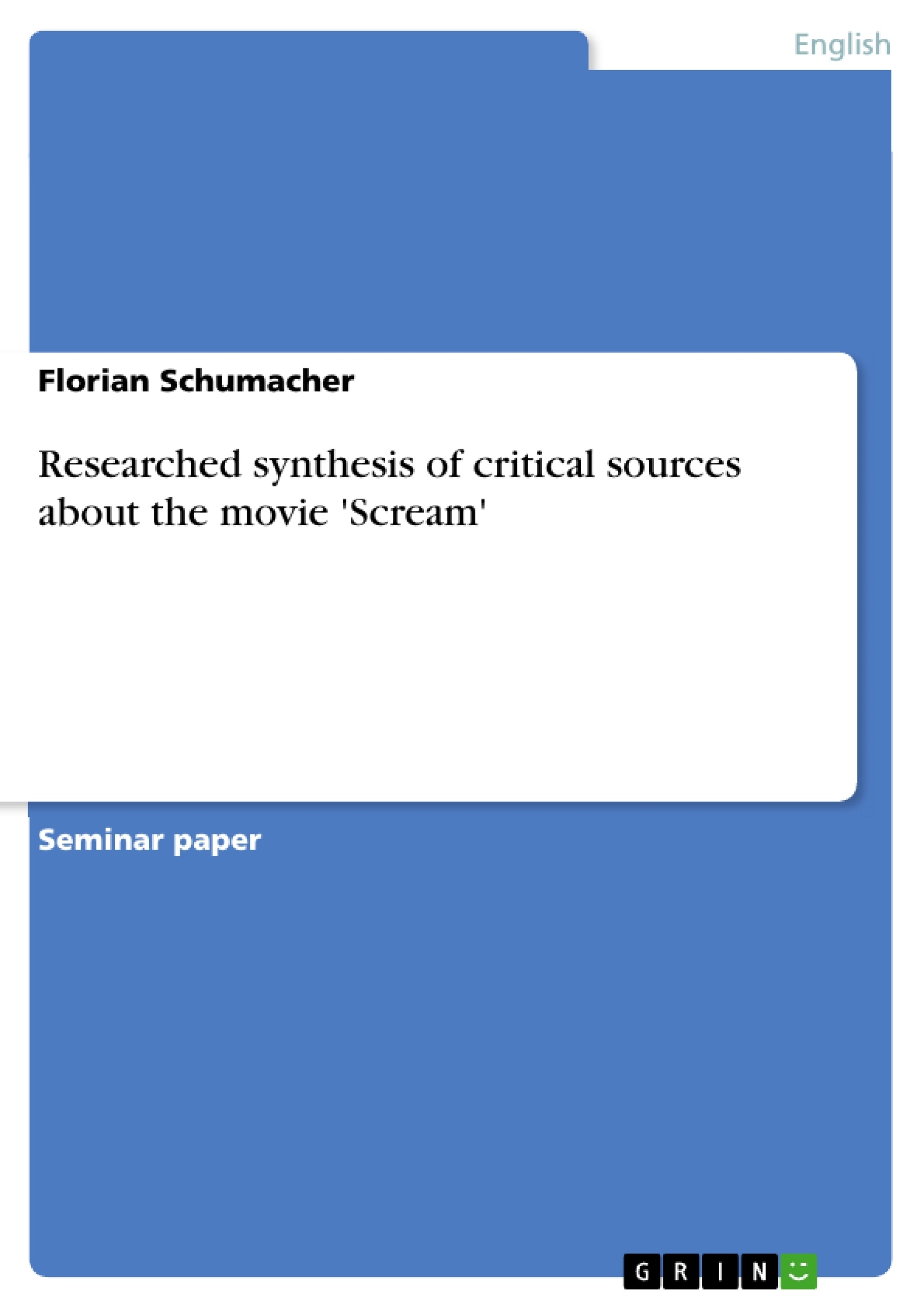In this research paper, I am going to analyze several critical sources that all deal with the movie Scream, directed by Wes Craven. This paper will show why Scream was a huge success and why it was totally different from any older slasher-movie. Even though this movie is scary and horrific, it is also a parody on older slasher-movies, it is extremely self-referential, and its characters are extremely knowledgeable about the horror-genre, which makes this movie funny and ironic and lets the audience experience a completely new kind of slasher-film. In the following, I will now summarize the critical articles that deal with Scream, after which I will discuss the relationships between these articles.
The first source I analyzed was a chapter about the movie Scream in John Kenneth Muir’s book Wes Craven – The Art of Horror. Muir starts this chapter with a quote from the Los Angeles Times, saying that Scream risks going way over the top, deliberately generating considerable laughter in the process, and that it ends up as terrific entertainment that also explores the relationship between movies and their audiences (from Kevin Thomas in The Los Angeles Times). Muir states that Scream is undeniably a horror masterpiece and that Craven achieved something extraordinary in a genre that is known neither for its intelligence nor for its wit. He thinks that Scream is exceptional because it is so intelligent, so witty, and most importantly scary. In Muir’s opinion, Scream is the ultimate tale of America’s VCR generation, which is extremely cynical and knows everything about the latest technologies (cell-phones, pagers, etc.). But it is also very referential, because the characters refer to movies or shows all the time, e.g. when two cheerleaders make up the theory that Sidney is the Woodsboro murderer – based on psychological arguments from “The Ricky Lake Show.” Muir thinks that because of the intense exposure to television and movies,
today’s teens are not only callous and cynical, they are also unbelievably smart as part of a defence mechanism to understand the modern world with all its technology.
Inhaltsverzeichnis (Table of Contents)
- Introduction
- Critical Sources on Scream
- John Kenneth Muir's "Wes Craven – The Art of Horror"
- Dr. Harvey O'Brien's Movie Review
- Kim Newman's Movie Review in Sight and Sound
- Philipp Wallutat's Movie Critique
- Comparison of Critical Sources
- Conclusion
Zielsetzung und Themenschwerpunkte (Objectives and Key Themes)
This research paper examines several critical sources that analyze the film "Scream" by Wes Craven. The paper aims to explore the reasons for the film's success and how it differed from traditional slasher movies. It also investigates the film's self-referential nature, its humor, and its impact on the horror genre. Key themes explored in the paper include: * **The Parody of Slasher Tropes:** The paper analyzes how "Scream" utilizes and subverts conventions of the slasher genre, drawing attention to its self-awareness and ironic approach. * **The Role of Self-Reference:** The paper investigates the significance of self-referential elements in "Scream," including its references to other horror films and its commentary on the relationship between movies and reality. * **Humor and Horror:** The paper explores how "Scream" successfully combines elements of horror and humor, achieving a unique and engaging cinematic experience. * **The Impact on the Horror Genre:** The paper examines the influence of "Scream" on the horror genre, particularly its contribution to the rise of self-aware and post-modern horror films. * **The Relationship Between Movies and Reality:** The paper investigates the film's exploration of the relationship between movies and reality, particularly its commentary on the impact of media violence on viewers.Zusammenfassung der Kapitel (Chapter Summaries)
The first chapter focuses on John Kenneth Muir's analysis of "Scream" in his book "Wes Craven – The Art of Horror." Muir argues that "Scream" is a horror masterpiece due to its intelligence, wit, and ability to scare. He believes the film captures the cynicism and technological savvy of the "VCR generation" while simultaneously critiquing the impact of media violence. The second chapter presents Dr. Harvey O'Brien's movie review, which criticizes "Scream" for its reliance on traditional horror tropes, despite its humor and self-awareness. O'Brien argues that the film's horror elements are ineffective and that its humor ultimately overshadows the film's intended scares. The third chapter examines Kim Newman's movie review in Sight and Sound. Newman argues that "Scream" is a successful post-modern horror film that utilizes parody and self-referentiality to engage with the conventions of the slasher genre. She highlights the film's irony, humor, and strong performances, while also acknowledging its ability to scare audiences. The fourth chapter focuses on Philipp Wallutat's movie critique. Wallutat argues that while "Scream" initially successfully combines parody and horror, it ultimately fails to maintain this balance. He criticizes the film for becoming overly absurd and unrealistic, ultimately leading to a loss of tension and a lack of innovation in the horror genre.Schlüsselwörter (Keywords)
The primary keywords and themes associated with this paper include "Scream," Wes Craven, slasher films, parody, self-reference, humor, horror, post-modernism, media violence, and the relationship between movies and reality. These terms reflect the core focus of the paper, which explores the film's unique combination of genre conventions, self-awareness, and critical commentary.- Quote paper
- Florian Schumacher (Author), 2004, Researched synthesis of critical sources about the movie 'Scream', Munich, GRIN Verlag, https://www.grin.com/document/113197




